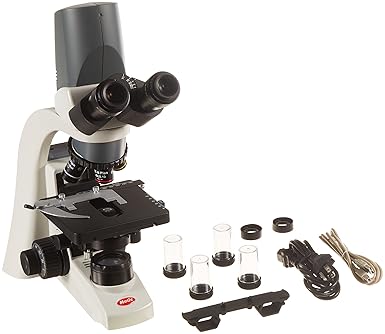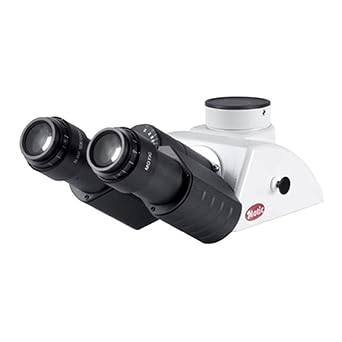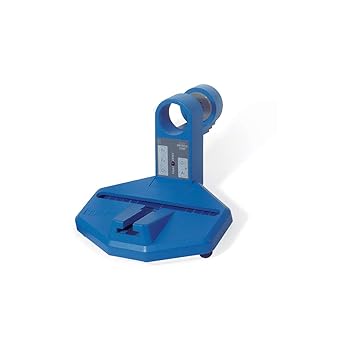
1100401200482 Series BA210 Basic Digital Siedentopf Binocular Compound Microscope, N-WF10x Eyepieces, Plan Objectives, 40x-1000x Magnification, Brightfield, Halogen Illumination, Abbe Condenser with Iris Diaphragm, Mechanical Stage, 110V, Includes 3.0MP C
Brand: Motic
Out of stock
- Digital compound microscope and 3.0MP CMOS camera with USB 2.0 output for capturing or displaying images on a computer or projector
- Siedentopf binocular head with pair of 20mm 10x widefield high-eyepoint eyepieces with 55 to 75mm interpupillary adjustment, and fixed 30-degree vertical inclination to reduce eye and neck strain
- Reverse-mounted nosepiece with 4x, 10x, 40xS, and 100xS (oil) CCIS EF-N plan achromatic objectives that provide color correction and focus over the entire range of the viewing field, and a longer working distance for improved focus when auxiliary components are utilized
- Brightfield, halogen illumination with rheostat and 1.25 NA Abbe condenser with iris diaphragm for clear examination and light control
- Mechanical stage locks slide into place and provides precise slide manipulation along the X- and Y-axes, and coaxial nested coarse and fine focus knobs speed focusing
Description
The Motic 1100401200482 Series BA210 Basic Digital Siedentopf Binocular Compound Microscope has a pair of 10x widefield high-eyepoint eyepieces, a reverse-mounted nosepiece with four color-corrected infinity optical system (CCIS) EF-N plan achromatic objectives, halogen illumination, nested coarse and fine focus, a 1.25 NA Abbe condenser with iris diaphragm, and a mechanical stage. The 3.0MP digital camera captures and displays images on a computer or projector. The Siedentopf binocular head has a pair of eyepieces with interpupillary adjustment, and a fixed inclination to reduce eye and neck strain. A Siedentopf binocular head enables the viewer to change the interpupillary distance without changing the tube length, eliminating the need to refocus the image. High-eyepoint eyepieces ease viewing for viewers wearing glasses. Dioptric adjustment accommodates individual eye-strength differences. A reverse-mounted nosepiece keeps objectives out of the way to prevent damage and contamination, and to enable more secure slide handling. CCIS EF-N plan achromatic objectives provide color correction and focus over the entire range of the viewing field, have a longer working distance for improved focus when auxiliary components are utilized, and have a multi-layer coating to enhance contrast. The 40xS and 100xS objectives are spring-loaded objectives that retract when they come into contact with the stage or slide, preventing slide damage when focusing. The 100xS objective is also an oil objective that provides increased resolution over a standard objective. A basic digital compound microscope is used in classroom, home school, and hobbyist settings for inspection and dissection of specimens when two-dimensional images are desired, and where image capture, detailed records, or documentation is required. The digital camera has a CMOS color sensor for displaying still microscopy images and streaming live videos to a computer or projector. It includes image capture and editing software that provides still image and live video capture and editing capability, including measurement functions. The software supports the Motic SFC file format and is compatible with Windows XP and above, and Mac OS X. The camera has a USB output. The microscope has lower (diascopic) brightfield illumination that transmits light up through the specimen for enhanced visibility of translucent and transparent objects. Brightfield (BF) illumination allows the specimen to absorb light, resulting in a dark image on a light background. The halogen light source provides bright light in a concentrated path, and a rheostat controls the amount of light emanating from the lamp. The Abbe condenser can be adjusted to control the distance of the light from the stage, has an iris diaphragm to optimize the amount of light illuminating the specimen, and has a slider slot to accept a phase or darkfield slider (sliders sold separately). A collector lens assembly holds the included blue filter that helps naturalize the light. The mechanical stage locks the slide into place and provides precise slide manipulation along the X- and Y-axes. Coaxial coarse and fine focus knobs are nested to speed focusing for left-and right-handed viewers, and tension adjustment ensures specimen stays focused during viewing. Microscope Head and Optics SpecificationsHeadBinocular, SiedentopfMagnification range40x-1000xHead inclination30 degreesInterpupillary adjustment55 to 75mmEyepieces (20mm)N-WF10xNosepieceQuadruple, reverse-mountedObjectives, CCIS EF-N plan achromatic4x, 10x, 40xS, and 100xS (oil) Microscope Illumination and Stage SpecificationsFocus typeCoaxial coarse and fineFocus travel range25mmCondenser1.25 NA AbbeLight sourceHalogen with rheostat, 6V/30WDiaphragmIrisIllumination typeBrightfieldStage typeMechanicalStage dimensions140 x 135mm (W x D)Stage travel range76 x 50mm (X-direction x Y-direction)Power110V W is width, the horizontal distance from left to right; D is depth, the horizontal distance from front to back. Camera SpecificationsResolution3MP (2048 x 1536 effective pixels)Image typeStill image and video display and captureCamera sensor1/3" Color CMOSComputer connectionUSB 2.0File formatSFC (Motic)Software packageImage capture and editing for Windows XP and above; Mac OS XCamera driver compatibilityWindows XP and above; Mac OS X Microscopes are instruments used to enhance the resolution of an object or image. Types include compound, stereo, or digital. Compound microscopes use a compound optical system with an objective lens and an eyepiece. Stereo microscopes show object depth in a three-dimensional image. Digital microscopes are used to display an image on a monitor, rather than looking through a lens. Microscopes can have monocular (one), binocular (two), or trinocular (three) eyepieces, with varying magnification abilities. Magnification ability refers to the size of an image. Resolution, also known as resolvant power, refers to the clarity of the image. The interaction between field of view (FOV), numerical aperture (NA), and working distance (WD) determines resolution. Microscopes can control magnification through a fixed focus, or through a range of adjustments. They can also utilize LED, fluorescent, and mirror light sources to help control viewing capabilities. Microscopes are widely used in education, lab research, biology, metallurgy, engineering, chemistry, manufacturing, and in the medical, forensic science, and veterinary industries. Motic manufactures microscopes, microscope cameras, digital imaging products, and application software. The company, founded in 1988 and headquartered in Xiamen, China, is a subsidiary of Hong Kong-based Speed Fair Co. Ltd. and meets International Organization for Standardization (ISO) standards 9001 and 14000. What's in the Box? Motic 1100401200482 Series BA210 Basic Digital Siedentopf Binocular Compound Microscope (2) N-WF10x eyepieces CCIS EF-N 4x plan achromatic objective CCIS EF-N 10x plan achromatic objective CCIS EF-N 40xS plan achromatic objective CCIS EF-N 100xS (oil) plan achromatic objective Blue filter, 45mm Calibration slide Software CD Immersion oil, 5ml Hex key Dust cover Power cord
Product Details
| Is Discontinued By Manufacturer ? | ? No |
| Product Dimensions ? | ? 18 x 13 x 29 inches; 23.05 Pounds |
| Item model number ? | ? 1100401200482 |
| Date First Available ? | ? July 18, 2012 |
| Manufacturer ? | ? Motic Instruments |
| ASIN ? | ? B00BWXO0XM |
| Country of Origin ? | ? China |






